Plex Media Server centralizes your personal video, music, and photo library so you can stream it anywhere without handing control to a paid service. The server optimizes media for each device automatically, supports multi-user libraries, and still lets you decide exactly where files live, making it ideal for self-hosted home theaters or lab environments.
This guide walks through installing Plex from the official repository with modern key management, opening the firewall, tunneling through SSH for secure first-time setup, completing the web wizard, enforcing file permissions, and optionally publishing Plex through an Nginx reverse proxy secured by Let’s Encrypt. Open a terminal with Ctrl+Alt+T or an SSH session before starting.
Install Plex Media Server on Ubuntu
Refresh Ubuntu Packages
Update existing packages so the APT tooling and system libraries Plex depends on are current:
sudo apt update && sudo apt upgrade -yReboot if the upgrade installs a new kernel or GLIBC release, then reconnect to the server.
Add the Official Plex Repository
Install the packages required to handle HTTPS repositories and vendor keyrings:
sudo apt install curl gnupg ca-certificates apt-transport-https software-properties-common lsb-release -yImport Plex’s signing key into /usr/share/keyrings/ so only packages signed by Plex are accepted:
curl -fsSL https://downloads.plex.tv/plex-keys/PlexSign.key | sudo gpg --dearmor -o /usr/share/keyrings/plex.gpgCreate a DEB822 repository definition so APT can pull Plex updates automatically:
sudo tee /etc/apt/sources.list.d/plexmediaserver.sources > /dev/null <<'EOF'
Types: deb
URIs: https://downloads.plex.tv/repo/deb
Suites: public
Components: main
Signed-By: /usr/share/keyrings/plex.gpg
EOFThe Signed-By line scopes the key to this repository only, preventing unrelated packages from trusting it.
Install Plex Media Server
Pull the latest package metadata and install Plex:
sudo apt update
sudo apt install plexmediaserver -yThe installer creates the plex system user, a systemd unit, and exposes the web interface on http://SERVER_IP:32400/web.
Verify the plexmediaserver Service
The daemon starts automatically. Confirm its status and exit the pager with q when finished:
sudo systemctl status --no-pager plexmediaserverThe output should resemble the following:
● plexmediaserver.service - Plex Media Server
Loaded: loaded (/lib/systemd/system/plexmediaserver.service; enabled)
Active: active (running) since Mon 2025-11-11 10:23:45 UTC; 2min 15s ago
Main PID: 12345 (Plex Media Serv)
Tasks: 45 (limit: 4915)
Memory: 256.5M
CPU: 3.142s

Use these commands when you need to manage the service manually:
sudo systemctl start plexmediaserver
sudo systemctl enable plexmediaserver
sudo systemctl restart plexmediaserverPrepare Network Access for Plex
Open Required Ports with UFW (Optional)
Ubuntu’s uncomplicated firewall (UFW) should allow SSH before you enable it, otherwise you will instantly lose remote access. Review our guide on enabling and disabling UFW on Ubuntu if you need a refresher.
Always allow SSH before turning on UFW. Even a short lapse locks out new sessions and may require an out-of-band console to fix.
Allow SSH, Plex’s default port, and the optional reverse-proxy ports:
sudo ufw allow OpenSSH
sudo ufw allow 32400/tcp
sudo ufw allow 80/tcp
sudo ufw allow 443/tcp
sudo ufw enableDisplay the rule set at any time with sudo ufw status numbered.
Create an SSH Tunnel for First-Time Setup
Plex restricts the initial configuration to localhost for security. Create a tunnel that forwards your workstation port 8888 to the server’s Plex port:
ssh -L 8888:localhost:32400 username@SERVER_IPIf SSH listens on a different port, add the -p flag:
ssh -p 2222 -L 8888:localhost:32400 username@SERVER_IPInstall and enable OpenSSH if your server image omitted it. Our SSH installation guide for Ubuntu covers hardening options after the base install:
sudo apt install openssh-server -y
sudo systemctl enable ssh --nowOnce the tunnel is active, browse to http://localhost:8888/web (or directly to http://localhost:32400/web/index.html#!/setup). After completing the wizard, you can connect on your LAN at http://SERVER_IP:32400/web or through Plex’s relay at app.plex.tv, which terminates on a trusted plex.direct hostname.
Complete the Plex Web Setup
The web wizard ensures Plex links to your account and can discover media paths. The screenshots below show each stage so you know what to expect.
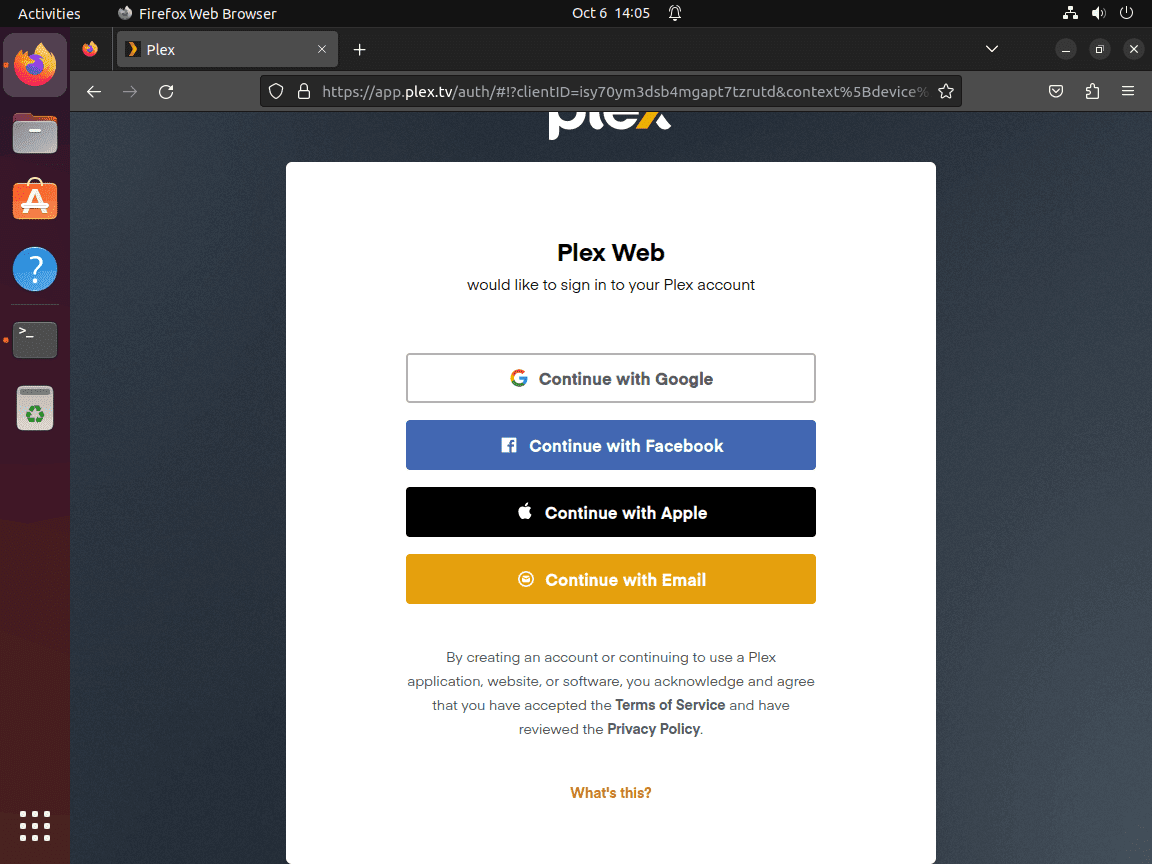
Sign in with an existing Plex, Google, Apple, or Facebook account, or create a new Plex account. Once authenticated, Plex explains how the server, apps, and relay service interact.
Walk Through the Welcome Prompts
The first screen summarizes Plex’s architecture. Click GOT IT! to continue.
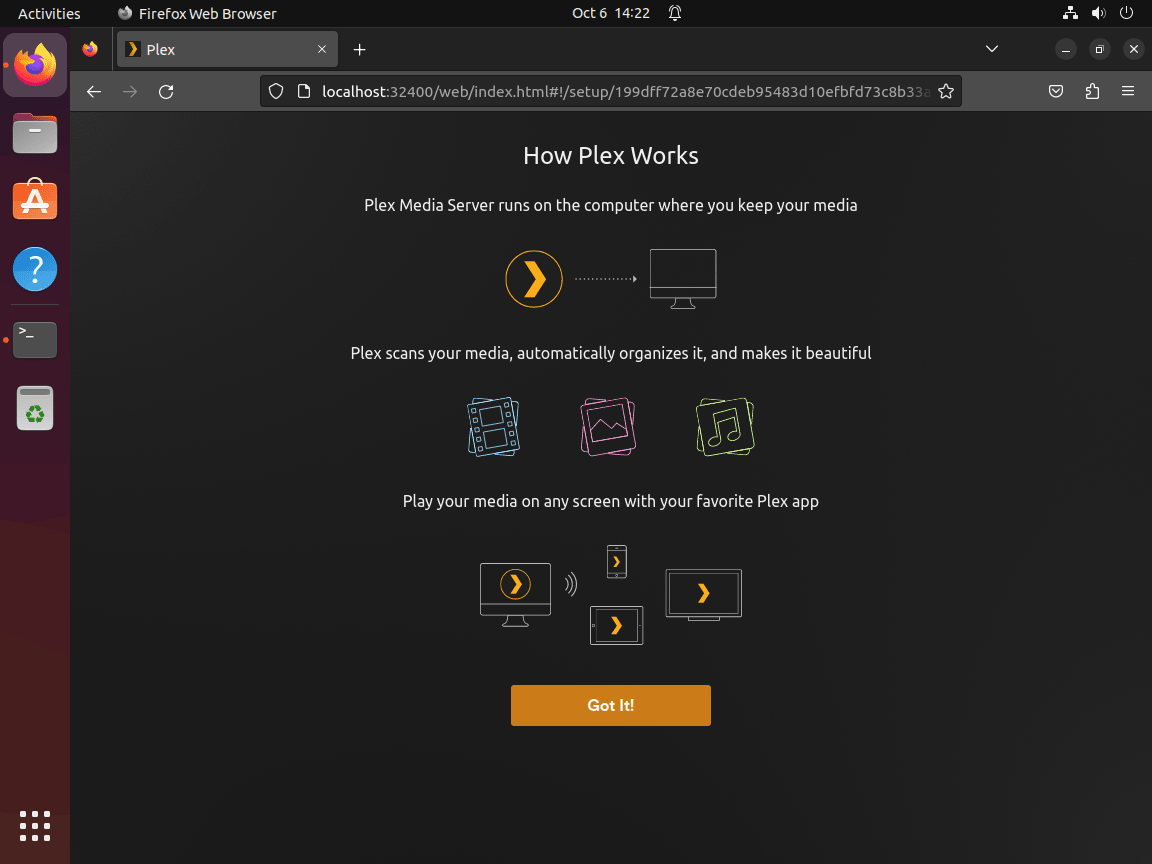
Firefox and other browsers may prompt you to enable DRM playback. Approve it so the Plex Web UI can display protected video previews.
Without DRM enabled, Firefox cannot load Plex’s web components correctly, and the setup wizard may stall on a blank screen.
Evaluate Plex Pass (Optional)
Plex offers a Plex Pass upsell that unlocks mobile sync, HDR tone mapping, and early access builds. Click the X in the corner if you are not ready to subscribe yet.
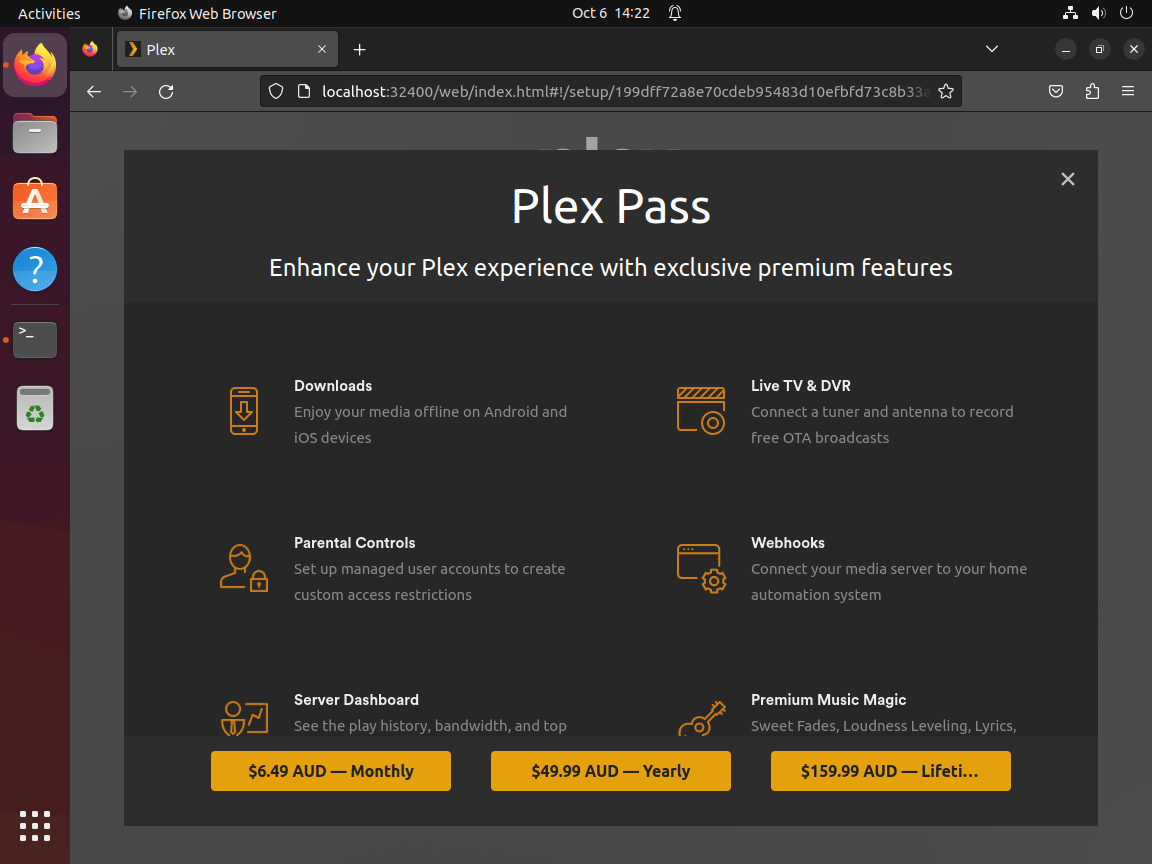
Name the Server and Enable Remote Access
Give the server a recognizable name and decide whether to keep Allow me to access my media outside my home enabled. Leaving it on lets Plex broker connections through plex.direct; disable it if you want to rely strictly on VPNs or your own reverse proxy.
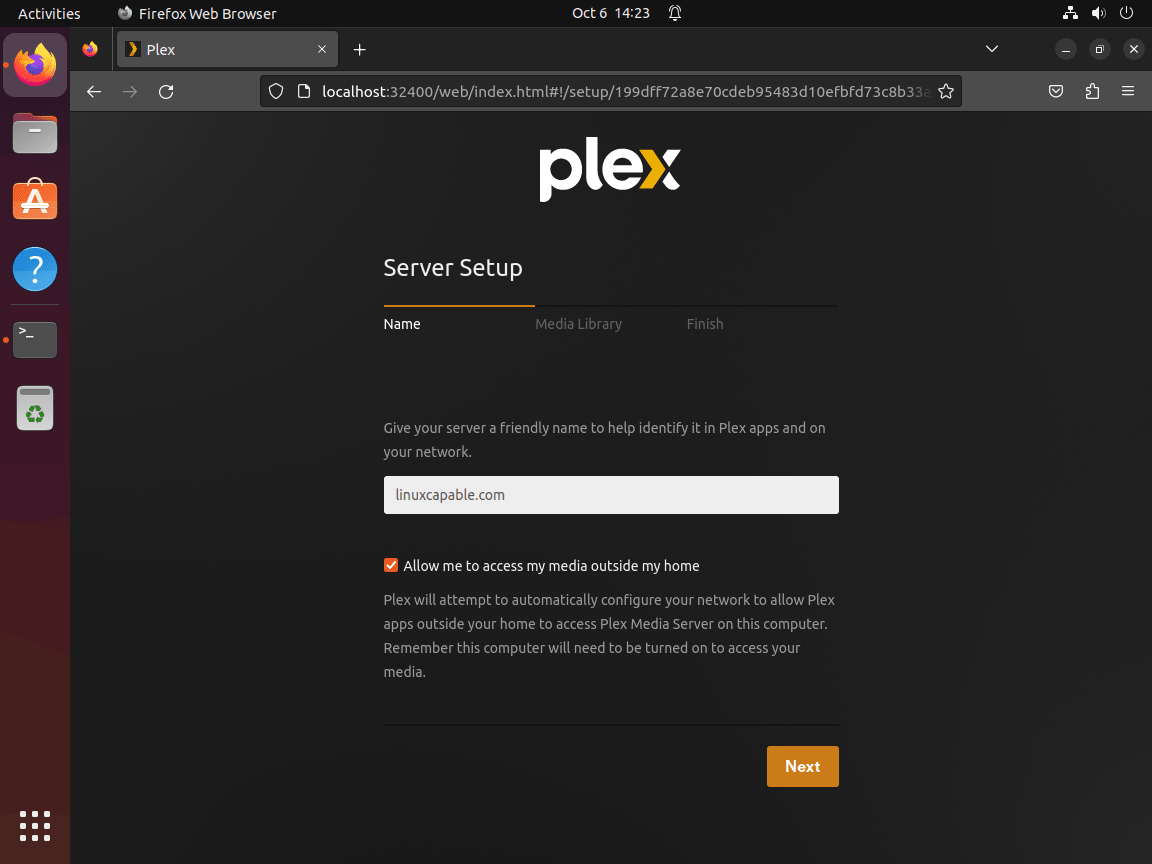
Add or Skip Media Libraries
You can pre-load media folders now or skip and return later from the dashboard. Click ADD LIBRARY when you are ready.
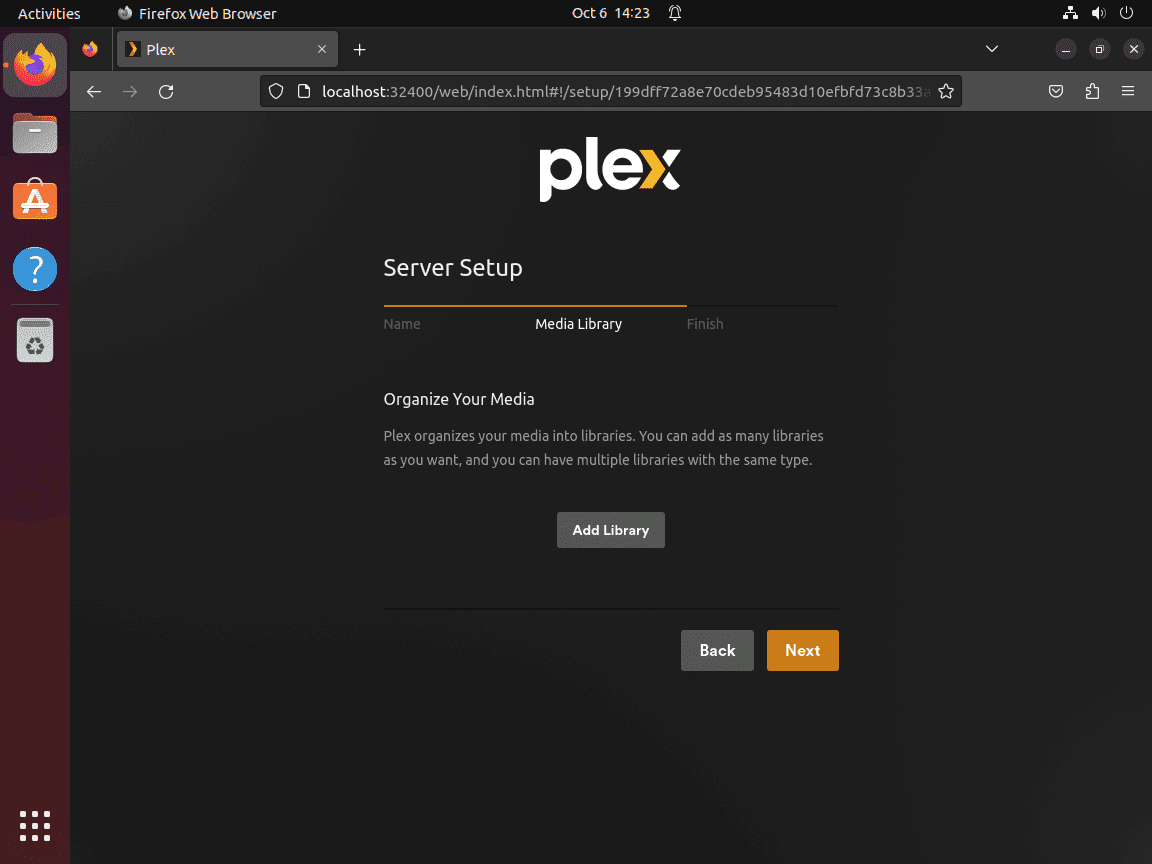
Choose the media type (Movies, TV, Music, etc.) so Plex knows which metadata agent to use.
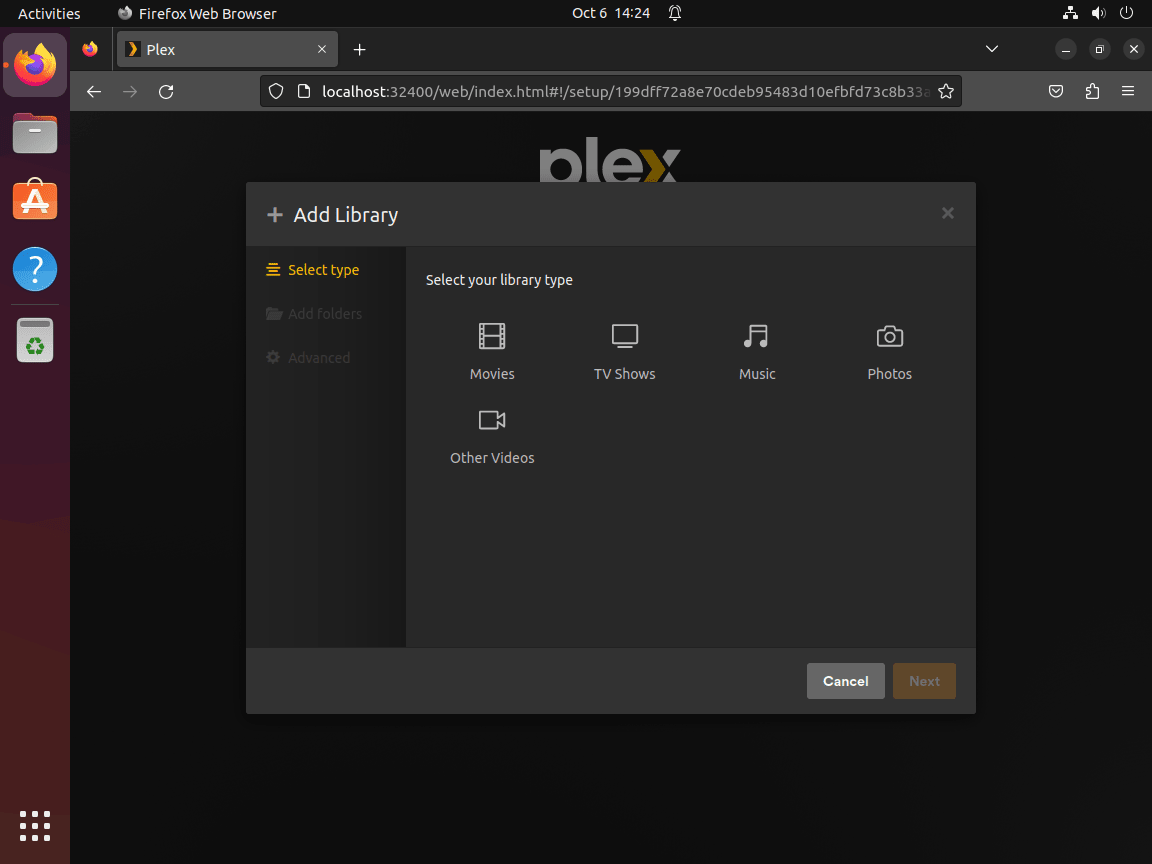
Click BROWSE FOR MEDIA FOLDER and point Plex to the directories mounted on your server. You can add multiple paths per library.
Skip the library step if your disks are not mounted yet—you can add them later from Settings > Manage > Libraries.
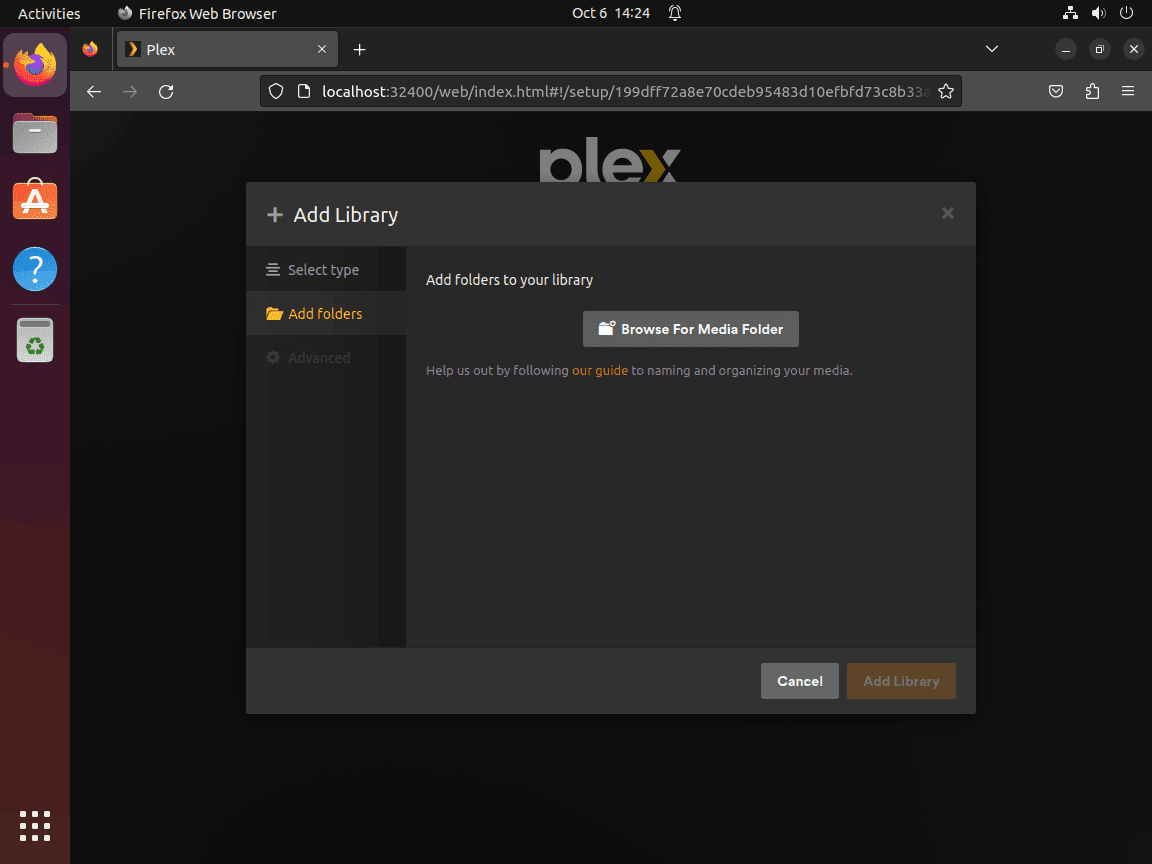
Use the Advanced options to control language, metadata agents, and whether Plex scans for changes automatically.
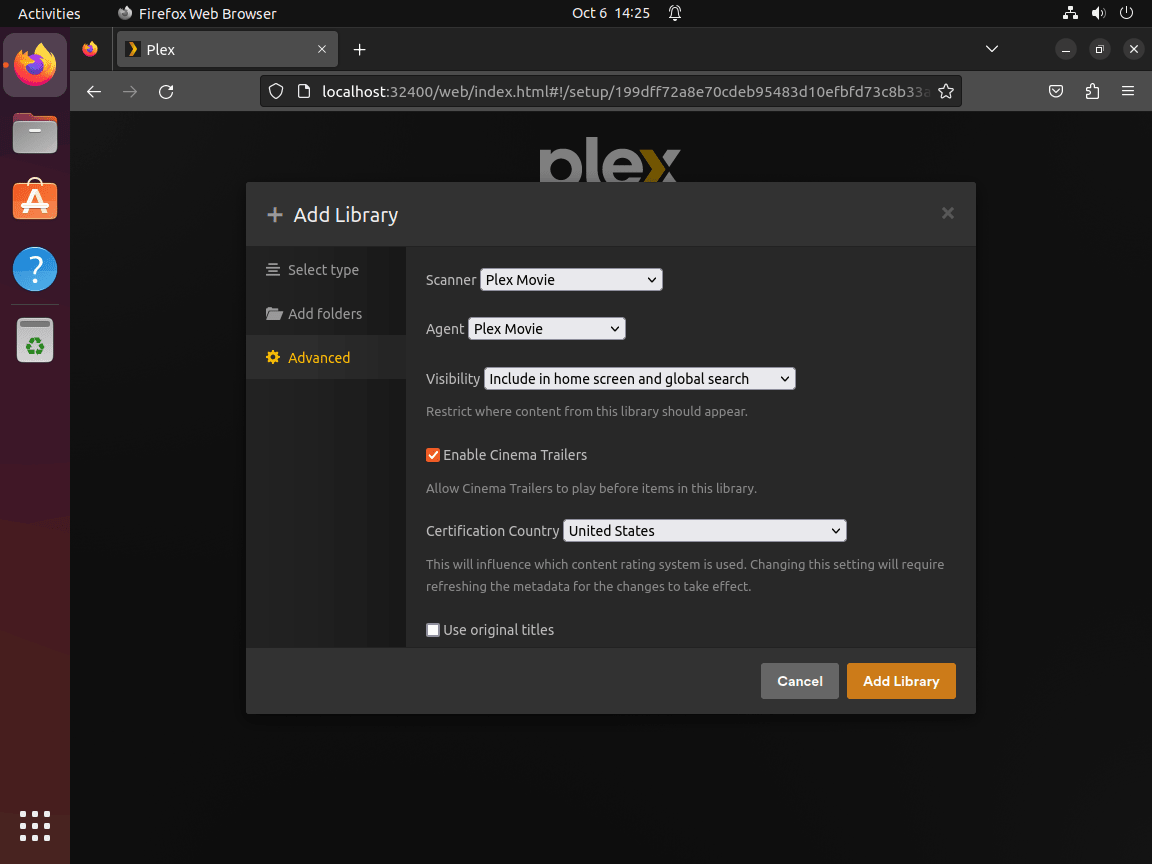
Control Library Scan Behavior
After the wizard finishes, open Settings → Library to decide how Plex watches for new content. These toggles keep libraries accurate without overloading slower CPUs or disks.
- Scan my library automatically: Leave this on so Plex reacts immediately when new files sync over SMB or NFS shares.
- Run a partial scan when changes are detected: Uses inotify to rescan only impacted folders instead of the whole collection, saving time on larger arrays.
- Update my library periodically: Schedule a nightly rescan if you ingest content through cron jobs or downloaders while you sleep.
Disable CPU-heavy extras such as “Generate video preview thumbnails” or “Generate intro video markers” on low-power hardware; you can re-enable them later once the initial metadata import is complete.
Finish the Wizard
Click NEXT once libraries are added (or skipped) and Plex will confirm the server is ready. Choose DONE to load the dashboard.

The dashboard confirms the server is online and ready for library scans.
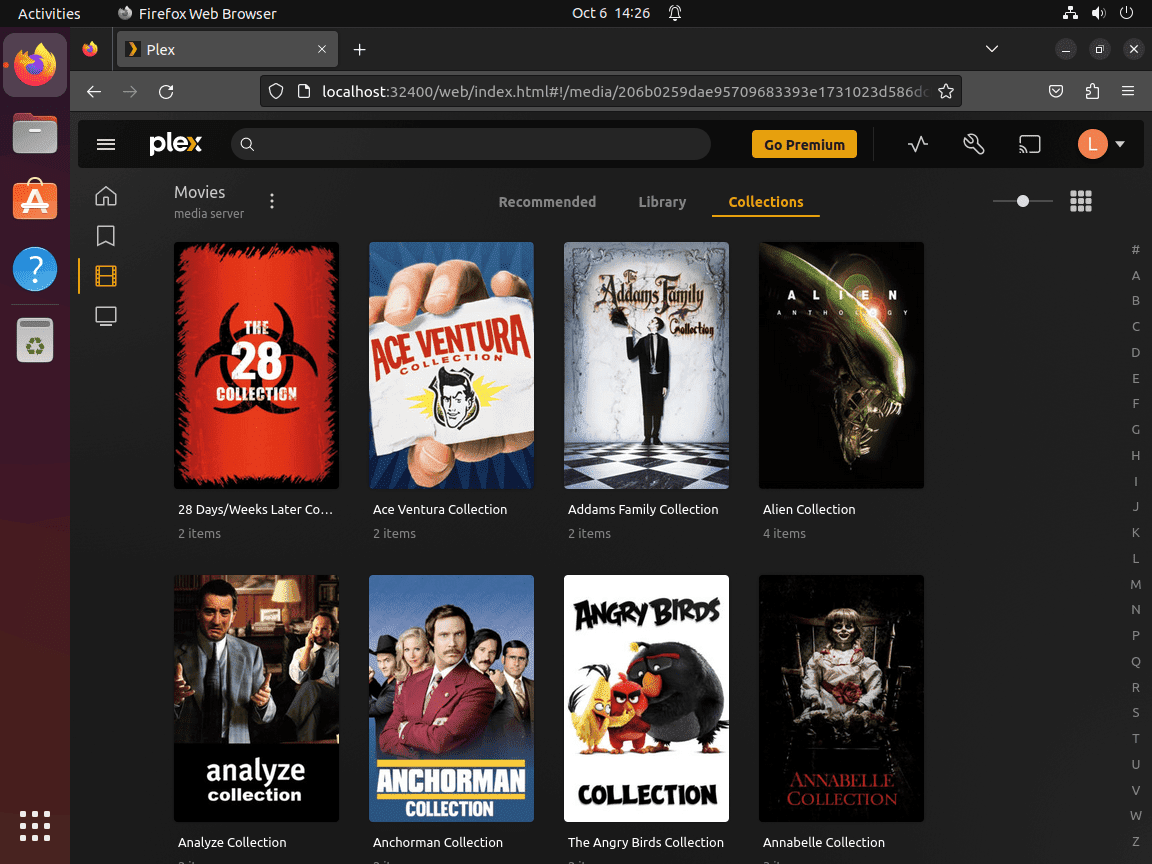
Configure Media File Permissions
The plex service account needs read and execute access to every media directory. ACLs preserve your existing ownership, while chown transfers ownership entirely to Plex.
Grant Access with setfacl (Recommended)
Install ACL utilities and grant Plex access to one or more library paths. Replace the example paths with your mount points:
sudo apt install acl -y
sudo setfacl -R -m u:plex:rx /media/yourfolder/
sudo setfacl -R -m u:plex:rx /media/yourfolder/tv
sudo setfacl -R -m u:plex:rx /media/yourfolder/movies
sudo setfacl -d -m u:plex:rx /media/yourfolder/The final command creates a default ACL so any new files dropped into that directory stay accessible. Confirm the rule with getfacl /media/yourfolder/.
Change Ownership with chown (Alternative)
If you prefer Plex to own the media outright, transfer ownership recursively. This method is simple but prevents other users or services from writing to the same folders unless you create additional ACLs.
For scenarios where multiple services still need write access, pair chown with the chmod command to fine-tune group permissions instead of granting Plex exclusive control.
sudo chown -R plex:plex /media/yourfolder/
sudo chown -R plex:plex /media/yourfolder/tv
sudo chown -R plex:plex /media/yourfolder/moviesRestart Plex if libraries were already added so it rescans with the new permissions:
sudo systemctl restart plexmediaserverSecure External Access with Nginx Reverse Proxy (Optional)
Plex’s built-in relay works, but reverse proxying your own domain offers better performance and lets you reuse existing TLS certificates. If you need a refresher on installing Nginx or tuning performance, review our guide on installing Nginx on Ubuntu.
Install and Configure Nginx
Install Nginx, enable it, and create a proxy configuration:
sudo apt install nginx -y
sudo systemctl enable nginx --now
sudo nano /etc/nginx/conf.d/plex.confAdd a server block that proxies requests to Plex’s local port. Replace plex.example.com with your domain.
server {
listen 80;
server_name plex.example.com;
location / {
proxy_http_version 1.1;
proxy_set_header Host $host;
proxy_set_header X-Real-IP $remote_addr;
proxy_set_header X-Forwarded-For $proxy_add_x_forwarded_for;
proxy_set_header X-Forwarded-Proto $scheme;
proxy_set_header Upgrade $http_upgrade;
proxy_set_header Connection "Upgrade";
proxy_pass http://127.0.0.1:32400;
proxy_read_timeout 3600;
}
}Save and exit, then test and reload Nginx:
sudo nginx -t
sudo systemctl reload nginxUpdate your DNS records so the Plex subdomain resolves to the server’s public IP. You can now browse to http://plex.example.com.
Add Let’s Encrypt SSL Certificates
Certbot automates TLS provisioning for Nginx. Install the plugin, request a certificate, and enable HTTP to HTTPS redirection:
sudo apt install python3-certbot-nginx -y
sudo certbot --nginx --agree-tos --redirect --hsts --staple-ocsp --email you@example.com -d plex.example.comCertbot updates plex.conf automatically. The --redirect flag forces HTTPS, --hsts adds a Strict-Transport-Security header, and --staple-ocsp improves certificate revocation checking. Replace the email and domain placeholders with real values.
Ubuntu’s Certbot package installs a systemd timer for renewals. Verify it once with a dry run:
sudo certbot renew --dry-runNo additional cron job is required; the timer triggers twice per day and renews certificates 30 days before expiration.
Manage Plex Media Server
Update Plex
Plex updates arrive through the repository you added earlier. Refresh package metadata and upgrade when new builds ship:
sudo apt update
sudo apt upgrade plexmediaserverRun sudo systemctl status plexmediaserver afterwards if you want to confirm the service restarted cleanly.
Remove Plex and Clean Up
When Plex is no longer required, remove the package and its repository definition:
sudo apt remove plexmediaserver
sudo rm /etc/apt/sources.list.d/plexmediaserver.sources
sudo rm /usr/share/keyrings/plex.gpg
sudo apt autoremove -yDelete any reverse proxy configuration or firewall rules you created if other services will reuse those ports.
Troubleshooting Common Issues
Plex Web Interface Not Accessible
Confirm the service is bound to port 32400 and review logs for binding errors or database corruption:
sudo systemctl status plexmediaserver
sudo ss -tulpn | grep 32400
sudo journalctl -u plexmediaserver -n 50Media Not Appearing in Libraries
Scan permissions from Plex’s perspective. These commands show whether the plex user can access each directory and which ACL entries apply:
sudo -u plex ls -la /media/yourfolder/
getfacl /media/yourfolder/Rescan the library from the Plex dashboard after fixing permissions.
Nginx Reverse Proxy Connection Issues
Syntax errors or missing DNS records commonly break the proxy. Validate the configuration, reload Nginx, and inspect the last 50 log entries:
sudo nginx -t
sudo systemctl reload nginx
sudo journalctl -u nginx -n 50Remote Access Still Shows Offline
Plex’s Remote Access page needs an open TCP 32400 path from the internet to your server. Confirm the server knows its public IP, the firewall allows the port, and your router forwards the connection.
curl -4 ifconfig.me
sudo ss -tulpn | grep 32400
sudo ufw status numberedUse the first command to verify the public IP shown in Plex matches your real address. The second confirms Plex is listening locally, and the third ensures UFW (or another firewall) allows port 32400. If those checks pass, log into your router and forward TCP 32400 to the Plex server’s LAN IP, then refresh the Remote Access page.
As a fallback, keep the SSH tunnel method from earlier sections handy; it gives you guaranteed access while you troubleshoot NAT or ISP restrictions.
First-Time User Tips
Organize Your Media Library
Plex’s metadata agents expect consistent naming. Adopt clean directory structures for every media type:
- Movies:
/media/movies/Movie Name (Year)/Movie Name (Year).mkv - TV Shows:
/media/tv/Show Name/Season 01/Show Name - S01E01.mkv - Music:
/media/music/Artist Name/Album Name/01 - Track Name.mp3
Including the year for films and the season/episode numbers for TV shows gives Plex enough data to pull the right posters and metadata.
Optimize Transcoding Performance
Transcoding converts high-bitrate masters into streams devices can handle. Keep sessions smooth with these tweaks:
- Enable hardware acceleration in Settings → Transcoder if your CPU or GPU supports Intel Quick Sync, AMD VCN, or NVIDIA NVENC.
- Point the transcoding temporary directory to SSD-backed storage so Plex does not stall on slow spinning disks.
- Ask remote users to pick the appropriate quality preset inside the Plex app to avoid unnecessary 4K to 1080p conversions.
Conclusion
Plex Media Server now runs from the official repository with secure key handling, controlled firewall exposure, guided setup, and hardened file permissions. Whether you keep it on your LAN or front it with an Nginx reverse proxy, remember to apply Ubuntu security updates consistently or enable unattended upgrades on Ubuntu so Plex’s dependencies stay patched.
Useful Links
Here are some valuable links related to using Plex:
- Plex Official Website: Visit the official Plex website for information about Plex Media Server, its features, and download options.
- Plex Support: Access the Plex support page for troubleshooting, guides, and FAQs to help resolve issues and optimize your Plex experience.
- Plex Forums: Join the Plex community forums to discuss issues, share solutions, and get support from other Plex users.

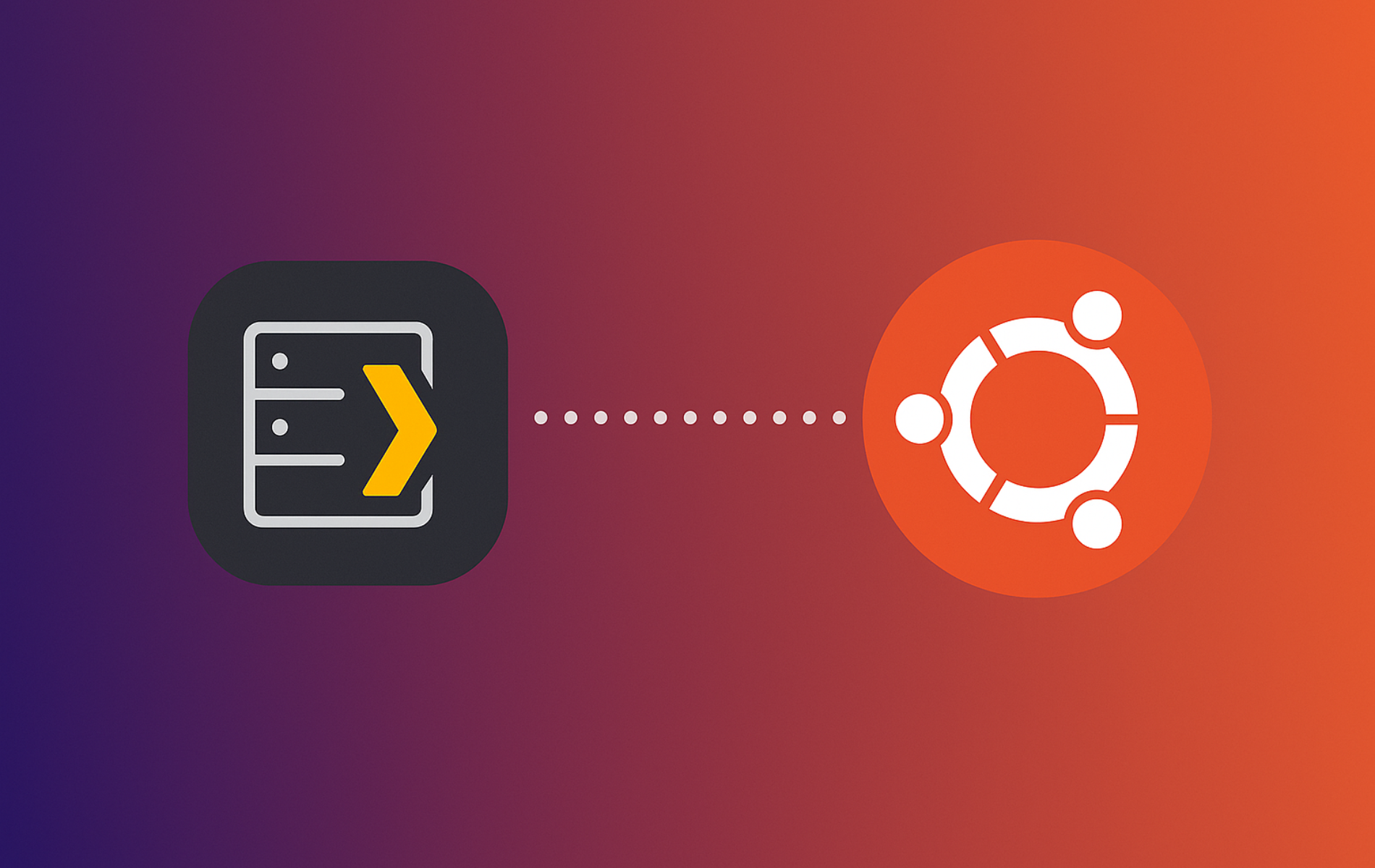
I’ve been trying to install Plex for 3 days before finding this amazing resource.
Worked 1st time.
THANK YOU THANK YOU THANK YOU
curl https://downloads.plex.tv/plex-keys/PlexSign.key | gpg –dearmor | sudo tee /usr/share/keyrings/plexserver.gpg > /dev/null
Seems to work…
Does not work on Ubuntu 22.04 minimized
curl -fsSL https://downloads.plex.tv/plex-keys/PlexSign.key | sudo gpg –dearmor | sudo tee /usr/share/keyrings/plex.gpg
That command fails… Displays junk on the screen.
Hi Earl, thanks for pointing that out! You’re absolutely right. On Ubuntu 22.04, some essential packages like
gpgandca-certificatesaren’t installed by default, which can break the command.The fix is simple: just install those missing packages first:
sudo apt install gpg ca-certificates -yThen, instead of the original command, try this:
curl -fsSL https://downloads.plex.tv/plex-keys/PlexSign.key | gpg --dearmor | sudo tee /usr/share/keyrings/plex.gpg > /dev/nullThis avoids potential issues if
gpgisn’t available yet.If anyone runs into permission issues, an alternative method is to store the key in
/etc/apt/trusted.gpg.d/:curl -fsSL https://downloads.plex.tv/plex-keys/PlexSign.key | gpg --dearmor | sudo tee /etc/apt/trusted.gpg.d/plex.gpg > /dev/nullBoth methods work fine, but Ubuntu’s preferred approach is to use
/usr/share/keyrings/in newer releases.Appreciate your feedback, it helps make the guide even better! Let me know if you run into any other issues. 🚀
Is this tutorial suitable for installing the 64-bit version?
I have not installed Plex Media Server on a 32-bit system before, but technically, it should if your architecture is supported. If it isn’t, then you will not be able to install it.
Just remove the source if it does not work, it will not take you long to test. Plex from memory does support 32bit.
Forget my previous answer as I misread your question. Yes, it is installable on a 64-bit system. Most of my guides are done on 64-bit architecture, as it is the main one used by many Linux users.